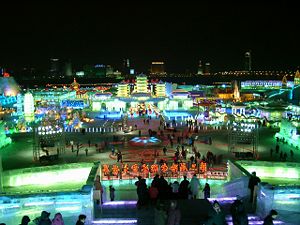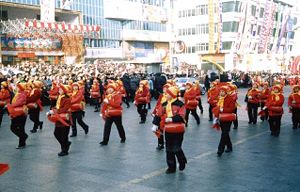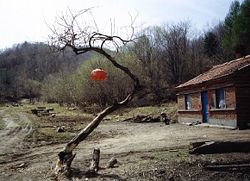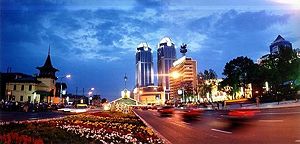Heilongjiang
| 黑龙江省 Hēilóngjiāng Shěng | |
| Abbreviations: 黑 (Pinyin: Hēi) | |
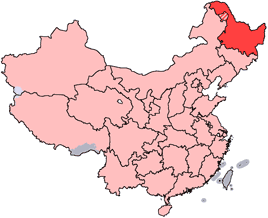
| |
| Origin of name | 黑 hēi—black 龙 lóng—dragon 江 jiāng—river "Amur River" |
| Administration type | Province |
| Capital (and largest city) |
Harbin |
| CPC Ctte Secretary | Ji Bingxuan (吉炳轩) |
| Governor | Wang Xiankui (王宪魁) |
| Area | 460,000 km² (6th) |
| Population (2010) - Density |
38,312,224 (15th) 80/km² (28th) |
| GDP (2011) - per capita |
CNY 1.25 trillion US$ 198.4 billion (16th) CNY 27,076 US$ 4,000 (16th) |
| HDI (2008) | 0.808 (high) (11th) |
| Major nationalities | Han: 95% Manchu: 3% Korean: 1% Mongol: 0.4% Hui: 0.3% |
| Prefecture-level | 13 divisions |
| County-level | 130 divisions |
| Township-level† | 1284 divisions |
| ISO 3166-2 | CN-23 |
| Official website www.hlj.gov.cn (Simplified Chinese) | |
Heilongjiang (Simplified Chinese: 黑龙江省; Traditional Chinese: 黑龍江省; pinyin: Hēilóngjiāng; Postal map spelling: Heilungkiang; Manchu: Sahaliyan ula) is a province of the People's Republic of China located in the northeastern part of the country. "Heilongjiang" literally means Black Dragon River, which is the Chinese name for the Amur River. The one-character abbreviation is 黑 (pinyin: Hēi), and the Manchu name of the region is Sahaliyan ula (literally meaning "Black river"), from which the name of Sakhalin island is derived. Heilongjiang borders Jilin to the south and Inner Mongolia to the west, and it also borders Russia to the north, with the Amur River marking the territorial border between the two countries. Heilongjiang contains both China's northernmost point (in Mohe County along the Amur) and easternmost point (at the junction of the Amur and Ussuri Rivers). Heilongjiang's culture is part of a culture of Northeast China that is relatively homogeneous across all northeastern China.
Heilongjiang's location in the furthermost northeast corner of China has cast the region's role in China. Situated on the border of Russia, with the Sea of Japan near at hand, Heilongjiang has been the point of contact between the three nations. The abundant natural resources have made the district important for China's economy, especially energy with huge oil reserves. Politically, Heilongjiang's role as the first region to come under communist control after the Soviet Union invaded at the close of World War II put the area center stage in China's political culture.
History
In ancient times, Heilongjiang was far from any literate civilization and information was sparse. Chinese and other sources state that Heilongjiang was inhabited by many different groups of people, including the Xianbei, the Mohe, and the Khitan. The eastern portion of Heilongjiang was ruled by the kingdom of Bohai between the seventh century and tenth century, and the Jurchen Jin Dynasty (1115-1234) that subsequently ruled much of northern China arose within the borders of modern Heilongjiang.
Under the Manchu Qing Dynasty, the western part of Heilongjiang was under the supervision of the General of Heilongjiang, whose power extended, according to the Treaty of Nerchinsk, as far north as the Stanovoy Mountains. Eastern Heilongjiang was under the supervision of the General of Jilin, whose power reached the Sea of Japan. These areas deep in the heart of Manchuria were closed off to Han Chinese migration.
However, in 1858 and 1860, the Qing government gave up all land beyond the Amur and Ussuri Rivers to Russia, cutting China off from the Sea of Japan and giving Heilongjiang its present northern borders. At the same time, Manchuria was opened to Han migration by the Qing government. As a result, by the early twentieth century, the Han Chinese had become the dominant ethnic group in the region. In 1932, present-day Heilongjiang became part of the Japanese puppet state of Manchukuo.
Upon the Japanese defeat in 1945, however, Soviet forces entered Manchuria, and gave the Chinese communists control over most of the area. Heilongjiang became the first province to be completely controlled by the Chinese communists and Harbin became the first major city under their control. From Manchuria, the communists were able to conduct the initial phases of the Chinese Civil War, which lasted until 1949.
At the beginning of communist rule, Heilongjiang province included only the western portion of the present-day province, and had its capital at Qiqihar. The remaining area was considered part of the province of Songjiang, with its capital at Harbin. In 1954, these two provinces were merged into present-day Heilongjiang, and Harbin became the capital of the newly combined province. During the Cultural Revolution, Heilongjiang was also expanded to include Hulunbuir League and some other areas previously in Inner Mongolia, but most of these changes were reversed later on.
Geography
Heilongjiang is a land of varied topography. Much of the province is dominated by mountain ranges such as the Greater Khingan Range and Lesser Khingan Range, Zhangguangcai Mountains, Laoye Mountains, and Wanda Mountains. The highest peak is Mount Datudingzi at 1,690 m (5,545 ft), located on the border with Jilin province. The Greater Khingan Range contains China's largest remaining virgin forest and is an important area for China's forestry industry.
Heilongjiang is one of China’s water-rich provinces. The interior of the province, which is relatively flat and low in altitude, contains the Songhua River, the Nen River, and the Mudan River, all tributaries of the Amur, while the northern border forms part of the Amur valley. Xingkai Lake (or Khanka Lake) is found on the border with Russia's Primorsky Krai. The province's numerous rivers form five distinct water systems, and there are also about 6,000 lakes and reservoirs, covering a surface area of more than 800,000 hectares within the area. About 70 percent of Heilongjiang's rainfall concentrates in the warm season, providing an ideal environment for plants and crops to grow. This water system also provides rich, good quality water resources for agriculture, industry, and human consumption.
In addition to these water resources, the province also has a great deal of forest coverage, which provides many kinds of biological and rich mineral resources. Heilongjiang ranks first among all Chinese provinces in forested area, reserves of forest resources, and timber output. It contains the most important state-owned forest area and the largest timber center in China, and its forests also contain more than 100 species of trees, including 30 of high use-value.
Heilongjiang is subarctic in climate. Winters are long and frigid, with an average of −31 to −15°C in January, and summers are short and cool with an average of 18 to 23°C in July. The annual average rainfall is 500 to 600 mm, concentrated mostly in summer.
Major Rivers and Lakes:
- Amur River
- Mudan River
- Songhua River
- Nen River
- Xingkai Lake
Major Cities:
- Harbin
- Qiqihar
- Mudanjiang
- Jiamusi
- Yichun
- Daqing
- Heihe
- Shuangyashan
Administrative divisions
Heilongjiang is divided into thirteen prefecture-level divisions, consisting of 12 prefecture-level cities and one prefecture:
- Harbin (Simplified Chinese: 哈尔滨市, Hanyu Pinyin: Hā'ěrbīn shì)
- Qiqihar (齐齐哈尔市 Qíqíhā'ěr shì)
- Hegang (鹤岗市 Hègǎng shì)
- Shuangyashan (双鸭山市 Shuāngyāshān shì)
- Jixi (鸡西市 Jīxī shì)
- Daqing (大庆市 Dàqìng shì)
- Yichun (伊春市 Yīchūn shì)
- Mudanjiang (牡丹江市 Mǔdānjiāng shì)
- Jiamusi (佳木斯市 Jiāmùsī shì)
- Qitaihe (七台河市 Qītáihé shì)
- Heihe (黑河市 Hēihé shì)
- Suihua (绥化市 Suíhuà shì)
- Daxing'anling Prefecture (大兴安岭地区 Dàxīng'ānlǐng Dìqū)
(About this last prefecture there is information to find at the section Greater Khingan)
The 13 prefecture-level divisions of Heilongjiang are subdivided into 130 county-level divisions (65 districts, 19 county-level cities, 45 counties, and one autonomous county). Those are in turn divided into 1,284 township-level divisions (473 towns, 400 townships, 58 ethnic townships, and 353 subdistricts).
Economy
Heilongjiang is one of the country's most important commodity grain production bases, in terms of both total production and storage of grains. The agriculture of Heilongjiang, heavily defined by its cold climate, is based upon crops such as soybeans, maize, and wheat. The province's annual output and export of soybeans ranks first in the country, and its exports of soybeans make up two-thirds of the country's total. Other important commercial crops grown in the region include beets, flax, tobacco, potatoes, and sunflowers.
Heilongjiang's significant forested area serves as an important source of lumber for China. Pine, especially Korean pine and larch are the most important forms of lumber produced in the province. Forests are mostly found in the Daxingan Mountains and Xiaoxingan Mountains, which are also home to protected animal species such as the Siberian Tiger, the red-crowned crane, and the lynx.
Herding in Heilongjiang is centered upon horse and cattle. Heilongjiang has the greatest number of milk cows and the highest production of milk among all the province-level divisions of China.
Petroleum is of great importance in Heilongjiang, as it has the largest amount of oil resources in all of China. The Daqing oilfield is not only the largest in China, but it also serves as one of the few remaining large oil fields in the entire world. In addition to petroleum, several other important minerals are also found in Heilongjiang, including coal, gold, lead, and graphite. Heilongjiang also has great potential for wind power, with an average wind energy density of 200 watts per square metre. This combination of wind and petroleum resources makes Heilongjiang a strategic and important energy source for the People's Republic of China.
Heilongjiang is part of northeast China (Manchuria), the traditional base of industry for the People's Republic of China. Industry is focused upon coal, petroleum, lumber, machinery, and food, and although the economic output in Heilongjiang ranks first in the nation, 90 percent of the materials are exported to other parts of China. Due to its location, Heilongjiang is also an important gateway for trade with Russia. In recent years however, the province and the greater Manchuria area has suffered from stagnation. As a result, the government has started the Revitalize Northeast China campaign to deal with this problem, using privatization as the preferred method of economic reform.
In 2005, Heilongjiang's nominal GDP was 551 billion yuan (US$68.87 billion), an annual growth rate of 11.6 percent. Its per capita GDP was 14,430 yuan (US$1,762). Heilongjiang's primary, secondary, and tertiary industries were worth 67.25 billion yuan, 297.08 billion yuan, and 186.67 billion yuan respectively.[1] The per capita disposable income of urban residents in Heilongjiang reached 8,273 yuan (over US$1,000), a rise of 10.7 percent from the previous year. The per capita net income of rural residents in the province surged 7.2 percent year-on-year to 3,221 yuan (US$400).[2]
Demographics
The majority of Heilongjiang's population is Han Chinese, while other ethnic minorities include the Manchus, Koreans, Mongols, Hui, Daur, Xibe, Oroqin, Hezhen, and Russians. Overall, there are 49 different ethnic groups within Heilongjiang province.
| Ethnic groups in Heilongjiang, 2000 census | ||
|---|---|---|
| Nationality | Population | Percentage |
| Han Chinese | 34,465,039 | 95.20% |
| Manchu | 1,037,080 | 2.86% |
| Koreans | 388,458 | 1.07% |
| Mongol | 141,495 | 0.39% |
| Hui | 124,003 | 0.34% |
| Daur | 43,608 | 0.12% |
| Xibe | 8,886 | 0.03% |
- Excludes members of the People's Liberation Army in active service.[3]
Education
At the end of 2000, Heilongjiang had 36 universities with 200,000 enrolled students and 16,000 teachers. In addition to this, the province had 3,023 middle schools with 2,708,000 students and 160,000 teachers, and 13,995 primary schools with 2,831,000 pupils and 193,000 teachers. The people in Heilongjiang have a relatively higher educational level than that of other regions with less illiteracy and semi-literacy. It is one of the provinces with a relatively high population quality in terms of education. Much of this can be attributed to the strong academic attendance rate among school-age children, which was 98.8 percent.
Colleges and universities
- Heilongjiang University
- Harbin Institute of Technology
Tourism
Heilongjiang has an abundant source of tourism resources. Harbin, the provincial capital, is a city of contrasts, with Chinese, Russian, and other eclectic worldwide influences clearly apparent. This influence is especially prominent in its architecture, with Eastern Orthodox, Roman Catholic, and Protestant churches dotting the city, providing an interesting cultural blend.
In addition to architecture, the long, cold winters felt by the province provide spots for ice and snow activities which are the best in all of China. The period for snow-skiing in the province lasts 120-140 days of the year, and the cold weather creates a unique backdrop for Harbin's} famed ice sculpture exhibitions. In 2007, the city put on its' 8th Ice and Snow World exhibition, which consisted of over 2,000 ice sculptures.[4] This event attracted numerous visitors to Harbin, providing a strong boost to the tourist industry of Heilongjiang. Heilongjiang Television and Harbin Economy Radio serve as broadcasters.
Heilongjiang's natural scenery includes the Wudalianchi Lakes, which are a series of five lakes formed between 1719 and 1721, by volcanic eruption. The volcanic activity shaped one section of a tributary of the Amur into five interconnected lakes, and the second lake in particular is renowned for its irregular geological sights. Jingbo Lake, found in Ning'an County, is a section of the Mudan river that has been narrowed and shaped by volcanic eruption into a series of sights, including the Diaoshuilou Falls. In general, the province's beautiful landscape, forests and grasslands, wetlands, rivers, and lakes provide rich resources for developing eco-tourism in the People's Republic of China.
Environmental/ecological issues
Two major environmental problems have risen to the forefront within Heilongjiang. The first is the quality of the atmosphere, which has diminished due to the strong presence of industry in urban areas within the province. The air pollution in cities is characteristic of typical sooty pollution, with suspending particles being the main pollutants. Of the ten cities monitored, six have their yearly average volume of suspending contaminated particles exceeding the state standard for second-class air quality. During winter, when heating is provided in cities, the air quality becomes significantly worse than in other seasons.
Along with the problem of air pollution, another significant problem in the province has been the quality of drinking water. Due to the presence of chemical factories in Harbin and other places in Heilongjiang, organic pollutants have seriously contaminated various rivers. During the frozen season, the lack of oxygen in river waters is also a serious problem, and the biological need for oxygen in waterways near cities exceeds the normal standard.
Notes
- ↑ NE China province reports record GDP growth, People's Daily Online. Retrieved April 24, 2008.
- ↑ People's Daily Online, Personal income up in NE. China province. Retrieved April 24, 2008.
- ↑ Department of Population, Social, Science and Technology Statistics of the National Bureau of Statistics of China (国家统计局人口和社会科技统计司) and Department of Economic Development of the State Ethnic Affairs Commission of China (国家民族事务委员会经济发展司), eds. Tabulation on Nationalities of 2000 Population Census of China (《2000年人口普查中国民族人口资料》) (Beijing: Nationalities Publishing House (民族出版社), 2003, ISBN 7105054255).
- ↑ China.org.cn, Ice and Snow Festival in Harbin. Retrieved April 24, 2008.
ReferencesISBN links support NWE through referral fees
- Asian Development Bank. 2006. People's Republic of China, Heilongjiang Road Network Development Project. [Manila]: Asian Development Bank. OCLC 69420302.
- Clausen, Søren, and Stig Thøgersen. 1995. The Making of a Chinese City: History and Historiography in Harbin. Armonk, NY: M.E. Sharpe. ISBN 9781563244759.
- Shan, Patrick Fuliang. 2006. "Insecurity, Outlawry and Social Order: Banditry in China's Heilongjiang Frontier Region, 1900-1931" Journal of Social History. 40 (1):25-54. OCLC 89883354.
- Winchester, Simon. 2000. "Black Dragon River—A narrow ribbon of water separates two worlds that could hardly be more different: An impoverished corner of Russia and China's economically energized Heilongjiang Province." National Geographic. 197 (2):2. OCLC 92549880.
- Yan, Yunxiang. 2003. Private Life Under Socialism: Love, Intimacy, and Family Change in a Chinese Village, 1949-1999. Stanford, Calif: Stanford University Press. ISBN 9780804733090.
External links
All links retrieved June 25, 2024.
| Province-level divisions administered by the People's Republic of China (PRC) | |
|---|---|
| Provinces | Anhui · Fujian · Gansu · Guangdong · Guizhou · Hainan · Hebei · Heilongjiang · Henan · Hubei · Hunan · Jiangsu · Jiangxi · Jilin · Liaoning · Qinghai · Shaanxi · Shandong · Shanxi · Sichuan · Taiwan · Yunnan · Zhejiang |
| Autonomous regions | Guangxi · Inner Mongolia · Ningxia · Tibet (Xizang) · Xinjiang |
| Municipalities | Beijing · Chongqing · Shanghai · Tianjin |
| Special administrative regions | Hong Kong · Macau |
Credits
New World Encyclopedia writers and editors rewrote and completed the Wikipedia article in accordance with New World Encyclopedia standards. This article abides by terms of the Creative Commons CC-by-sa 3.0 License (CC-by-sa), which may be used and disseminated with proper attribution. Credit is due under the terms of this license that can reference both the New World Encyclopedia contributors and the selfless volunteer contributors of the Wikimedia Foundation. To cite this article click here for a list of acceptable citing formats.The history of earlier contributions by wikipedians is accessible to researchers here:
The history of this article since it was imported to New World Encyclopedia:
Note: Some restrictions may apply to use of individual images which are separately licensed.
